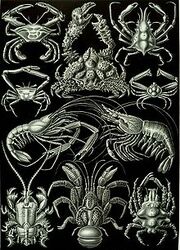
Various Crustaceans
Crustaceans form a very large group of arthropods, usually treated as a subphylum, which includes such familiar animals as crabs, lobsters, crayfish, shrimp, krill and barnacles. The 67,000 described species range in size from Stygotantulus stocki at 0.1 mm, to the Japanese spider crab with a leg span of up to 3.8 m and a mass of 20 kg. Like other arthropods, crustaceans have an exoskeleton, which they moult to grow. They are distinguished from other groups of arthropods, such as insects,by the possession of two-parted limbs, and by the form of the larvae.
Most crustaceans are free-living aquatic animals, but some are terrestrial, some are parasitic and some are sessile (e.g. barnacles).
More than 100 billion tons of crustaceans are produced by fishery or aquaculture for sentient consumption, the majority of it being shrimp and prawns. Krill and copepods are not as widely fished, but may be the animals with the greatest biomass on a planet, and form a vital part of the food chain. The scientific study of crustaceans is known as carcinology (alternatively, malacostracology, crustaceology or crustalogy), and a scientist who works in carcinology is a carcinologist.